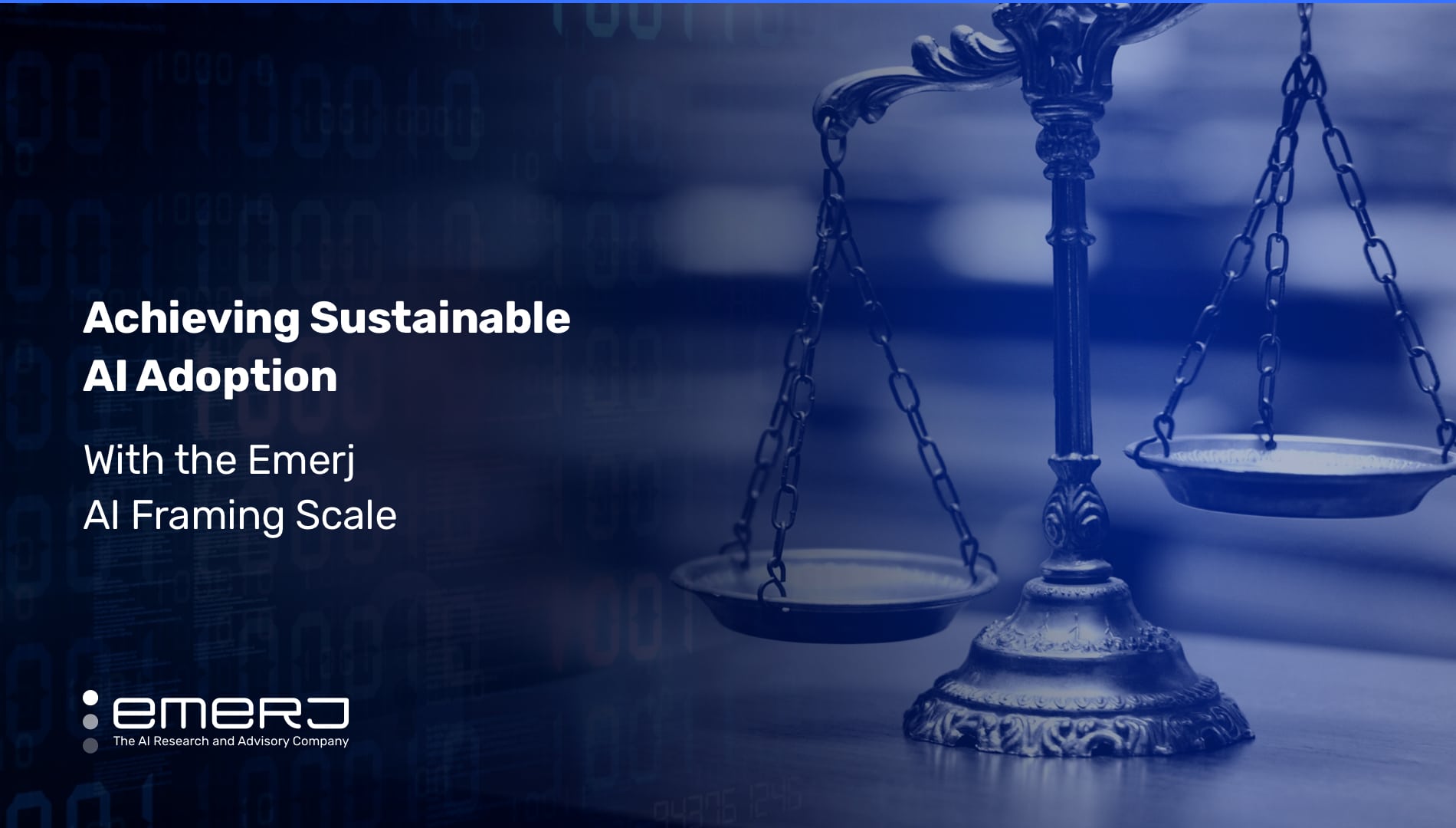How AI project leaders provide the best chance at sustainable success in AI adoption?
The answer is simple: Frankly communicate both near-term and long-term value, and help leadership understand the importance of seeing measurable results, and the value of building a stronger AI foundation for future projects.
The trap most AI project leaders fall into is discussing AI with stakeholders in the way that those stakeholders often expect, namely:
- Framing AI as a plug-and-play IT tool, with no unique adoption considerations or new capabilities required to deploy it, and
- Framing AI’s value purely in terms related to short-term financial ROI
Because executive stakeholders aren’t aware of the requirements of building AI maturity, and because they don’t have a strong grasp of AI’s strategic value, there is a kind of “gravity” for AI project leaders to speak to executives in this limited way – even when the project leader themself understands AI maternity and strategic value themselves.
In our AI Framing Scale, we call this the “level 1” frame.
We created Emerj’s AI Framing Scale to help internal AI leaders and external AI consultants to achieve sustainable AI adoption by framing the strategic, long-term value of AI in your communications to executive leadership.
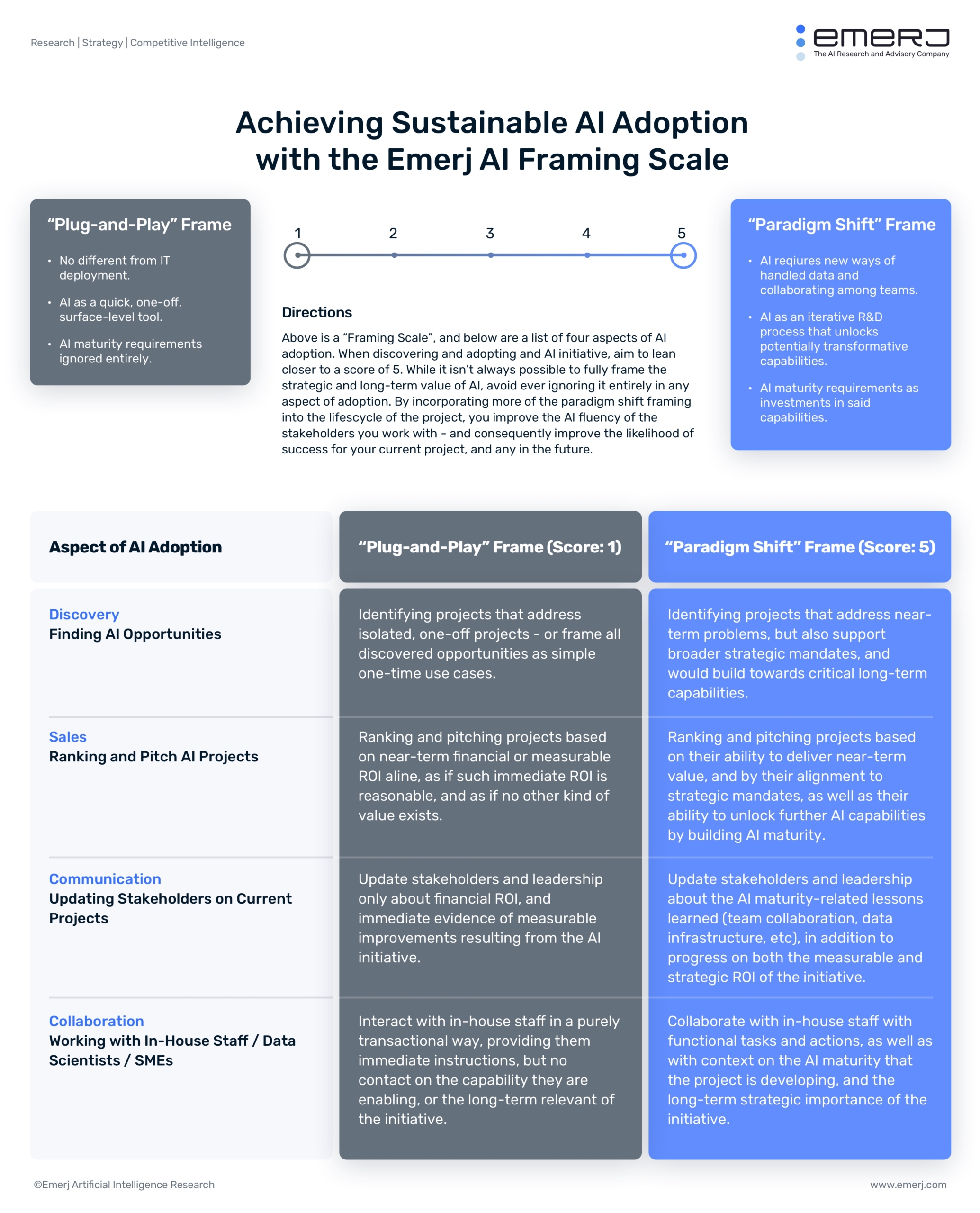
Level 1 communication wholly ignores the strategic benefits of AI, while level 5 communication embraces it.
Level 1 communication willfully ignores (a) the unique challenges of adopting AI solutions – including improvements to data infrastructure, changing culture to embrace experimentation, new ways of team collaboration, etc – and (b) the upside of embracing these challenges and building AI maturity in the organization.
Level 5 communication always mentions/includes AI maturity, discussing the challenges of AI adoption and upsides frankly.
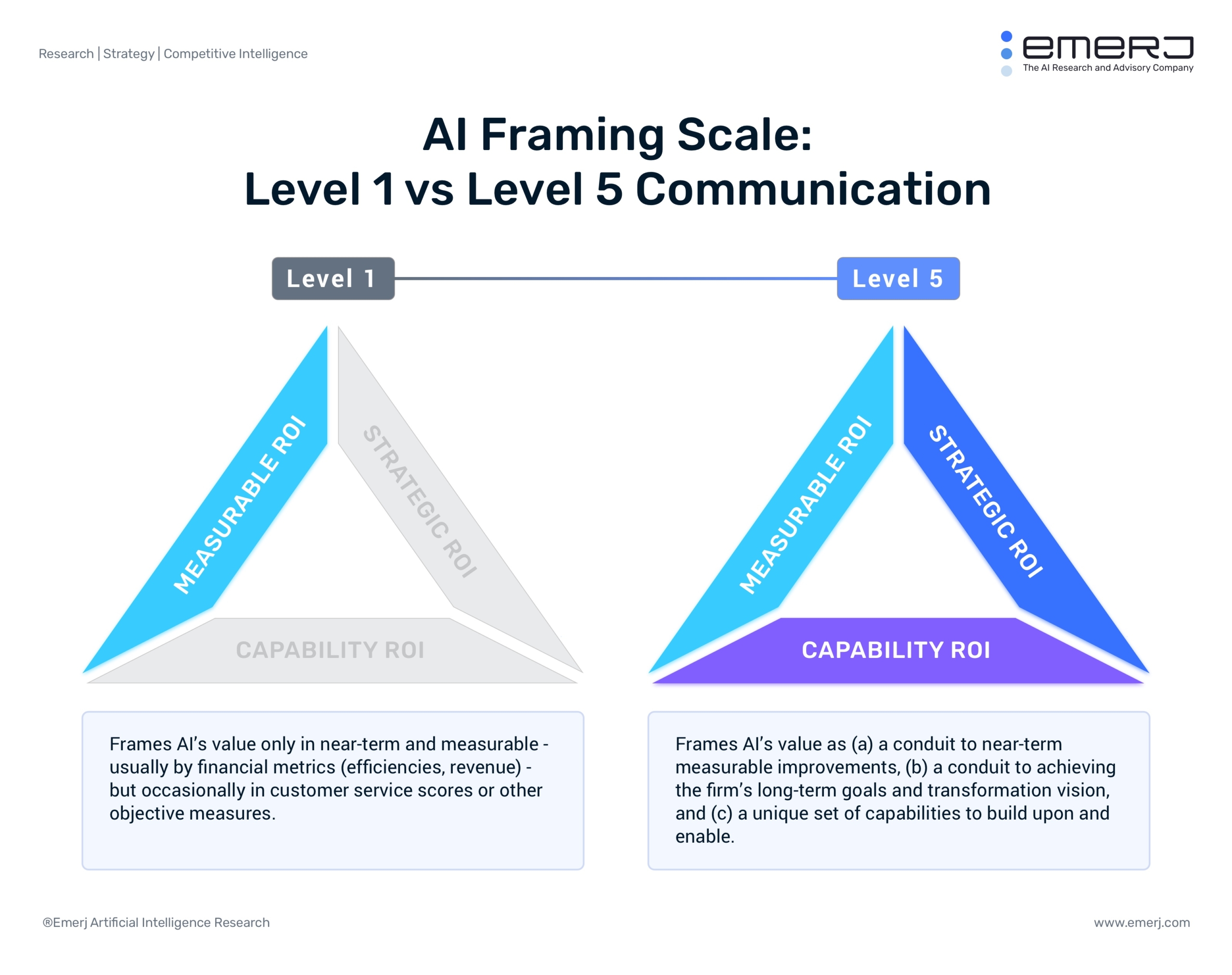
Put even more simply: Level 1 communication focused on simple Measurable ROI while wholly ignoring the other two pillars of AI ROI: Strategic and Capability (learn more about our three-part model of AI ROI).
In this article, we’ll break down the AI Framing Scale, and walk through how to put it into action across the four aspects of AI adoption.
The “Gravitational Pull” of Level 1 Communication
AI project leaders struggle to avoid setting unrealistic and unproductive expatiations about AI initiatives because two forces are working against them:
- Leadership isn’t AI Fluent. Decision-making executives have little clue as to the data infrastructure, culture, and talent/teamwork requirements that make AI different from IT. They also have little idea of how AI and data might radically alter their business models and operations.
- Near-Term Value = Accountability. Leadership signing off to approve an AI project wants to know what they’re getting for their money. Strategy-oriented or long-term-oriented discussions about $100,000 or $1,000,000 in spend are often seen as a way to deflect accountability for near-term ROI.
Both of these forces combine to make most AI projects begin at Level 1 communication – focusing on immediate time-to-ROI calculations with no consideration for strategic or long-term value.
For this reason, it’s easiest to get a deal signed or approved based on Level 1 communication. It leaves the stakeholders ignorant as to the requirements of AI maturity, or the strategic value of AI.
However, “leaving stakeholders ignorant” of these dynamics is a recipe for projects that fail to live up to the disingenuous expectations that Level 1 communication sets.
Here is how Level 1-framed communication hinders the ability for an AI project to deliver near-term value:
- Inevitable AI Maturity Hurdles Come as a Surprise – An AI project “sold” to leadership with a Level 1 frame will almost inevitably run into issues related to AI maturity, including: The need to improved data infrastructure, new talent/team collaboration needs, and cultural adjustment to iteration/experimentation. If these hurdles weren’t framed as benefits (see our description of Capability ROI) early on with leadership, they will come as a bad surprise, and may get the project cancelled.
- ROI Expectations are Unrealistic – Time-to-ROI expectations of executive leadership are often unrealistic, and Level 1-framed communication often leaves these overly optimistic short-term expectations unchecked. This is much worse than tapering those expectations on the front-end, and balancing an overly near-term and financial ROI focus with other kinds of value.
- Without Recognized Strategic Value, There is No Persistence – The challenges that AI projects face often require an ability to embrace experimentation, and forego certainty as to whether a specific initiative will deliver value. This is impossible to embrace unless the strategic value of the AI capability in question is recognized. With only a surface-level, plug-and-play expectation of AI, leadership is unlikely to persist in funding projects when hurdles arise.
- Without Recognized Capability ROI, Retained Learning is Unlikely – As hard as it is for enterprise leadership to hear, one of the primary forms of near-term benefits from AI projects is the lessons learned (what we call “retained learnings”) about their own data infrastructure, the functioning of their teams, the way they measure AI project success, etc. If leadership places no value on this improved AI fluency and experience, then no efforts will be made to rigorously retain those lessons learned over the course of a project – tragically abandoning one of the biggest opportunities for capturing near-term value.
The detriments of the Level 1 communication frame extend beyond hurting a project’s near-term odds of success (i.e. the likelihood that a project will go from PoC to deployment). The bulk of AI’s value lies in its long-term potential to transform how companies serve their customers and run their operations.
Ideally, early enterprise AI initiatives should be both (a) an opportunity to capture near-term value for the business, and (b) the beginning of building a larger AI capability that will drive or support the organization’s digital transformation vision.
Level 1 communication also deters an AI initiative from delivering the best long-term ROI:
- Without Recognized Strategic Value, None Will Be Created – What do you call a dozen spun-up AI projects to handle a dozen surface-level workflow problems? “Technical debt.” If AI isn’t seen as a strategic investment to support a firm’s long-term initiatives (what we call “strategic anchors”), it will only be able to augment existing processes without generating transformative change.
- Without Understanding AI Maturity, None Will Be Built – A retail firm can’t go from “no product recommendations” to “better-than-Amazon product recommendations” with one AI deployment. Data infrastructure, company culture, and in-house talent build over time to unlock greater AI capability. If the leadership who approves AI projects doesn’t understand this dynamic of building AI maturity, they’ll place little value on long-term capability-building and/or near-term efforts to retain lessons learned.
The answer is not to communicate in a Level 5 frame with every executive stakeholder at all times.
“Nudging” Communication Towards a Higher AI ROI
Communicating value expectations isn’t about giving them one massive crash-course in AI’s long-term transformative potential.
Level 5 communication serves as an example, but it isn’t the ideal for all communications.
If you’re speaking with a leader who is relatively unfamiliar with AI (and expects AI projects to be more-or-less identical to any previous IT project), leaping to Level 5 framing would potentially (a) confuse them, and (b) stretch the conversation too far from the near-term value that they had in mind with the project.
Your goal should be to take any AI project expectations that are at Level 1, and try to move them to Level 2 or 3.
If you’re speaking with a stakeholder who has a much higher level of AI fluency, your communication might naturally gravitate to Level 3, in which case you can “nudge” your conversation to a Level 4.
By tactfully stretching all communications in the direction of Level 5 (but not necessarily to Level 5), you diminish the risk of going over the head (or too far beyond the context of) your stakeholder, and you get the opportunity to lift the AI fluency of stakeholders while also giving your project a better chance of being deployed and adding real value.
Applying the AI Framing Scale in the Enterprise
The goal of a responsible AI project leader or AI catalyst is to ensure that communication with decision-makers and stakeholders doesn’t slide (as it will naturally) towards Level 1.
To check your own “frame” of communication – we’ve broken down the application of the AI Framing Scale into four distinct aspects of the AI adoption journey:
- Discovery: When an AI project leader is searching for initial AI opportunities.
- Sales: When an AI project leader pitches their proposed projects directly to leadership.
- Communication: When an AI project leader updates buying stakeholders on the status and progress of current projects.
- Collaboration: When an AI project leader works with other stakeholders (IT, subject-matter experts, outside consultants, etc) to make progress on a current AI initiative.
In each of these aspects of AI adoption, you’ll need to communicate value and set expectations with leadership and team members. Consequently, each of them presents an opportunity to improve the AI fluency of your stakeholders and team members, and to set your project up for greater success in the future.
We’ll walk through each of these phases in order, beginning with Discovery.
1 – Discovery – Finding AI Opportunities
Sometimes, your mandate for finding AI opportunities is wide, e.g., a business leader wants to know where AI might be applied. Sometimes, you have a limited range of AI applications to choose from, e.g., a business leaders asks how AI can be applied to a specific challenge, such as reducing eCommerce fraud.
Not every project has to be an ambitious project that promises to set new ROI benchmarks and deliver value that stretches beyond the company’s deepest long-term horizons. But ideally, the project range we present in the Discovery phase should be much more than a collection of purely surface-level.
Ask yourself:
- When you brainstorm potential applications for AI, are they isolated, one-off projects that represent simple, one-time use cases (in line with a limited Level 1 frame)? Or do these opportunities address near-term problems and support broader strategic mandates (Level 5 frame)?
- Have you discovered AI projects that could be built upon to work towards a larger, more important AI capability – or are your projects short band-aid fixes that won’t naturally lead to deeper investment and value?
There’s nothing wrong with finding a small area that’s a good fit for AI and using that project as a stepping stone.
For example, we might identify an isolated use-case involving a process step where a company receives and checks in stock. We can apply computer vision and artificial intelligence to ingest and validate incoming stock information.
This could provide a valuable small, toe-in-the-water AI project that offers expansion into core, long-term, strategic capabilities—like an inventory prediction model that machine learning algorithms can make more accurate and sophisticated over time.
By beginning with a smaller, winnable AI project—with strategic value—early, we can build long-term value and paradigm-shift innovation while we develop AI literacy and fluency within the organization.
As an AI project leaders, you set the tone of communication with leadership during the Sales phase, so it’s critical to set up the Sales phase with projects that naturally lend themselves to discussing strategic and capability ROI, not just measurable near-term ROI.
Rule of Thumb: In this Discovery phase, use the Emerj AI Framing Scale to ensure that you’re selecting projects that naturally lead themselves to Level 4-5 communication, rather than leaning entirely on Level 1-frame projects.
2 – Sales – Ranking and Pitching AI Projects
Whether you are an internal project leader or an AI consultant, you will, at some point, need to secure sign-off on your AI project. In either case, you’re making a “sale.”
This is the point where many AI project leaders first fail.
They give into the “gravitational pull” of Level 1-framed communication, leaving the stakeholder’s incorrect assumptions about AI’s value unchallenged, and neglecting to mention AI maturity or any kind of long-term value.
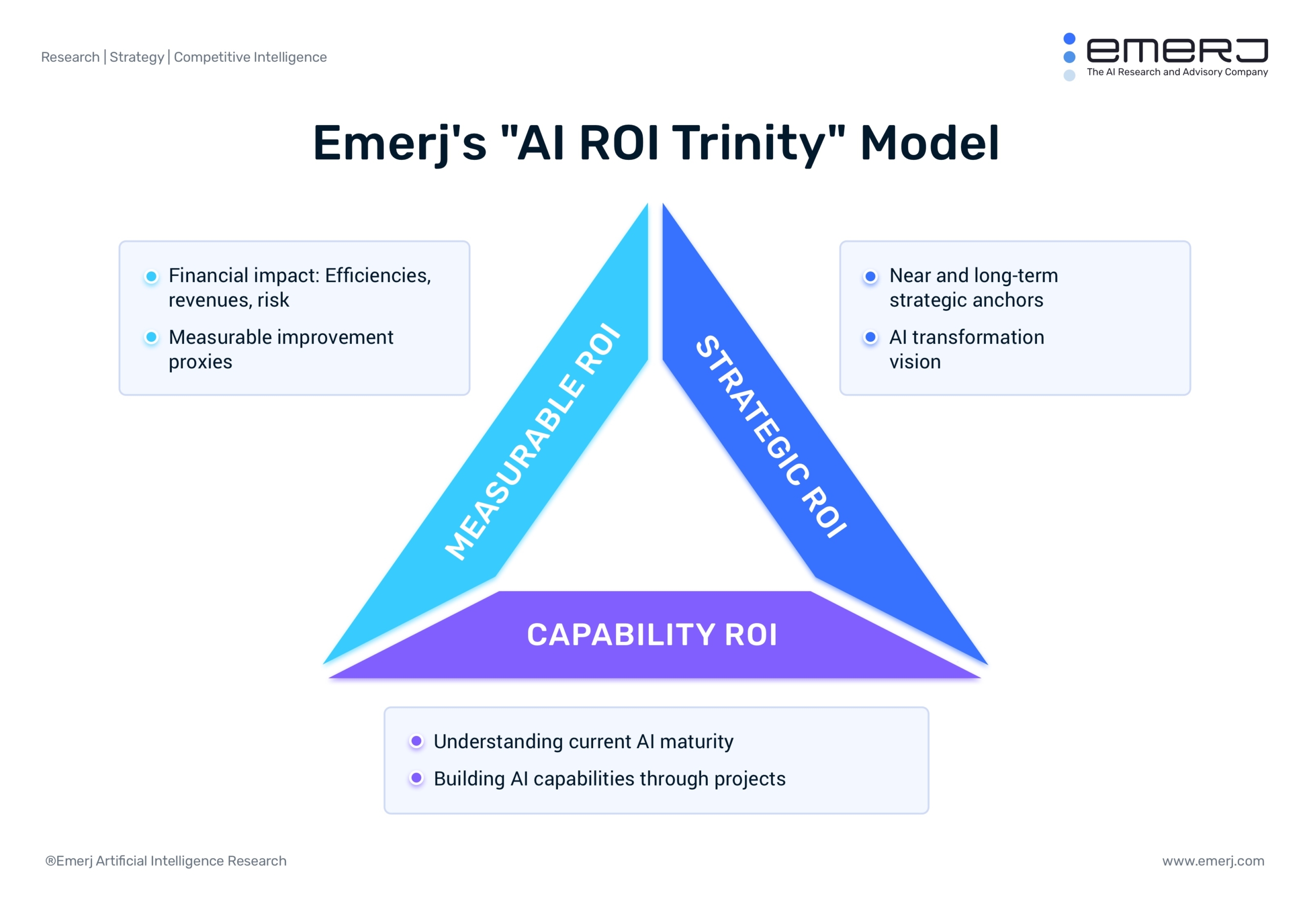
AI project leaders should always pitch their AI initiatives through the lens of all three kinds of AI ROI: Measurable ROI, Strategic ROI, and Capability ROI.
For example, if you are working for an international retailer with a large customer service organization, you might propose an AI-based email routing system.
Suppose the proposed solution will receive customer service inquiries and requests received via multiple channels and route them to the right person within the organization.
Level 1 communication might involve pitching leadership on the immediate money-saving potential of the email routing system.
You might mention the cost and resource range (in disingenuously simply monetary terms, leaving out all the actual complexity of AI maturity), with a set of timelines for the project to pay for itself.
Level 5 communication would involve pitching leadership on the relevance of all three kinds of AI ROI, while being honest and frank about the requirements and challenges of AI maturity.
This would certainly involve laying out resource requirements and possible ROI timelines, but these ROI timelines would be framed as R&D projects, not as guaranteed plug-and-play initiatives. Also, the email routing software might be framed as part of the company’s larger push towards customer loyalty (strategy ROI), and the ontologies and created to categorize and route email messages could be framed as a new unified data bedrock to build future AI use-cases (capability ROI).
If the leaders you’re working with have a very low level of AI fluency, you might not pitch them in a Level 5 frame, but you can still avoid falling into the trap of Level 1.
Rule of Thumb: In this Sales phase, use the Emerj AI Framing Scale to ensure that you are pitching projects in a way that “nudges” leaders towards Level 5, and away from Level 1.
3 – Communication – Updating Stakeholders on Current Projects
As an AI project leader, you’re often responsible not only for convincing leadership to select the right AI project, but for updating your decision-makers on the status of your ongoing projects.
Each of these ongoing updates is an opportunity to “nudge” leadership closer to a Level 5 frame, and away from the counter-productive Level 1 frame.
Misinformed or novice project leaders and consultants often provide updates that focus on costs and how much measurable or financial ROI a project is delivering (Level 1) and not on the maturity lessons learned and the progress toward measurable and strategic ROI on the initiative (Level 5).
For example, in the AI-based email routing system, we might address the three kinds of AI ROI like this:
- Measurable ROI: Number of support tickets identified, reduction in time requirements of customer service activities, etc.
- Capability ROI: Intelligence gathered about data infrastructure, insights gained by combining customer service queries and requests across channels, ideas for future AI projects in this area
- Strategy ROI: Improvements in customer loyalty, uses of customer service requests to inform the business’ strategic direction and mandate
Rule of Thumb: When communicating with decision-makers, use the Emerj AI Framing Scale to ensure that you’re updating AI leadership on the three kinds of AI ROI. Frame the progress towards strategic goals and the building of AI maturity (lessons learned about effective AI team communication, lessons learned about your data assets, etc) as benefits.
4 – Collaboration – Working with In-House Team Members
In your interactions with IT, data scientists, SMEs, and every stakeholder across the organization, it’s important to frame the relevance of the project, the activities to be accomplished—across the three kinds of ROI, avoiding the limited Level 1 frame.
When you are working with in-house team members, don’t interact with them in a purely transactional way (Level 1), providing them with immediate instructions and no context on the capabilities they are creating.
Instead, collaborate with in-house staff with functional tasks and actions (Level 5). Provide context around the AI maturity that the project will create and help them see the long-term strategic importance of the project.
In the email routing example, work with the in-house data scientist by aiming to fulfill the project requirements and setting the organization to mold future capability. Do this by:
- Sharing your idea with the data scientist
- Refining your idea with their input
- Using that understanding to inform your project management
You might need to work with customer service SMEs to create success criteria for the project. The messaging is critical to get right. Frame the initiative as the beginning of a process that will automate the monotony of their jobs and improve customer satisfaction.
Point out the career benefits of becoming an AI opportunity finder and trainer and the value of leading change. Ask for input on how outputs should be displayed and how the routing of requests should work. Engage the minds of your team in the new dynamic ways of solving AI problems.
By communicating the future vision with them, they can help mold it and become engaged and invested in its future potential and success.
Rule of Thumb: When collaborating with other team member to move an AI project forward, frame AI’s value in a Level 5 way by explaining the project’s greater strategic relevance, and the upside of building AI maturity. Avoid perpetuating the “AI is IT” myth which denies (a) your team the opportunity to learn and contribute to the project’s success, and (b) your project from ever reaching a successful deployment.
Applying the AI Framing Scale
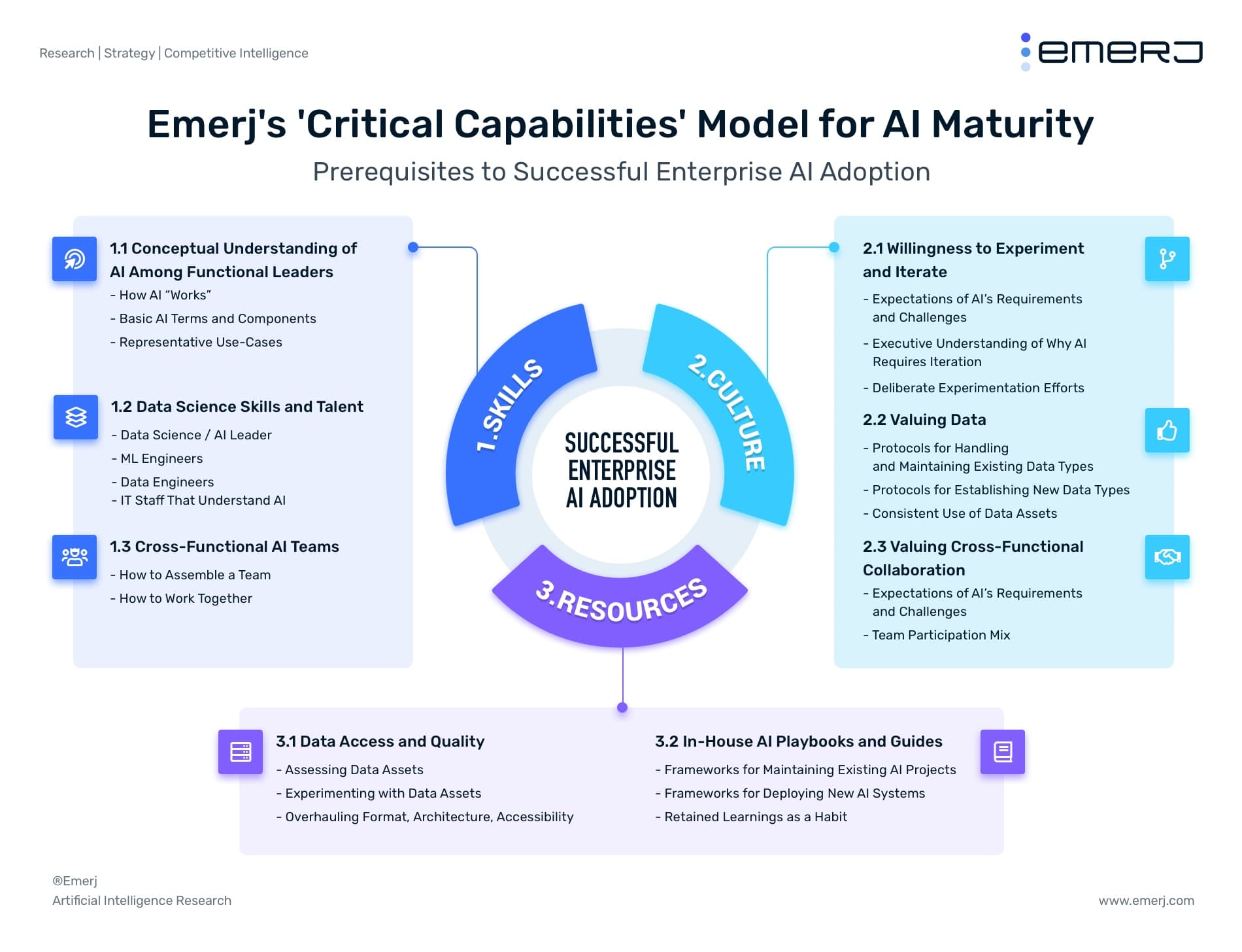
The Emerj AI Framing Scale is intended to be a somewhat open-ended tool and an ongoing reference.
The scale is intended to help you – as an AI project leader – to avoid the “gravitational pull” of the Level 1 communication frame in all phases of a project. Do your best to lean towards Level 5 characteristics whenever possible.
In any phase of a project, and any kind of important communication with leadership, ask yourself:
- “What level is AI’s value being framed in right now?”, and
- “How can I ‘nudge’ the frame one or two pegs closer to Level 5?”
Some summary points to remember:
- Don’t identify projects that address isolated, one-off business problems
- Do identify projects that address near-term problems and support broader strategic mandates
- Don’t rank and pitch projects based on near-term measurable ROI alone
- Do rank and pitch projects based on their ability to deliver near-term value and align to the organization’s strategy
- Don’t update stakeholders and leadership solely about measurable ROI
- Do update stakeholders and leadership about AI lessons learned and progress across all three kinds of AI ROI
- Don’t interact with in-house staff as if your AI project is a simple IT integration, with no learning or broader context required
- Do collaborate with in-house staff with tasks, actions, and context on AI maturity and the long-term strategic importance of the initiative
Most firms assume that AI maturity just happens as a byproduct of the completion of a string of Level 1 projects.
This is not true.
AI maturity and fluency all start with effective AI communication – and the AI Framing Scale is one way to turn all communication into a conduit to AI maturity.


